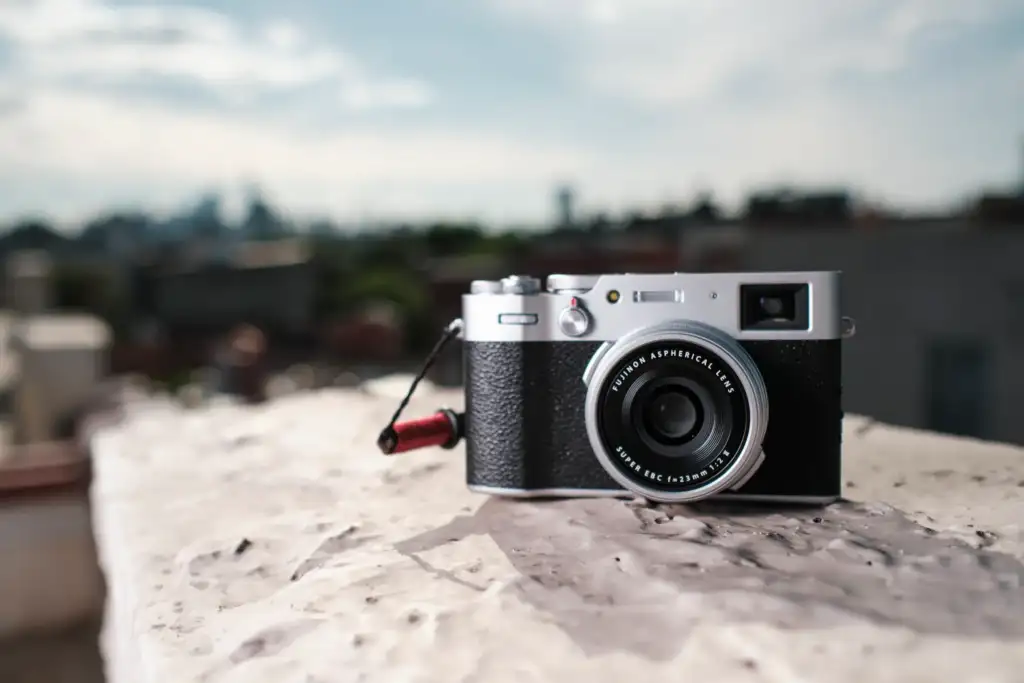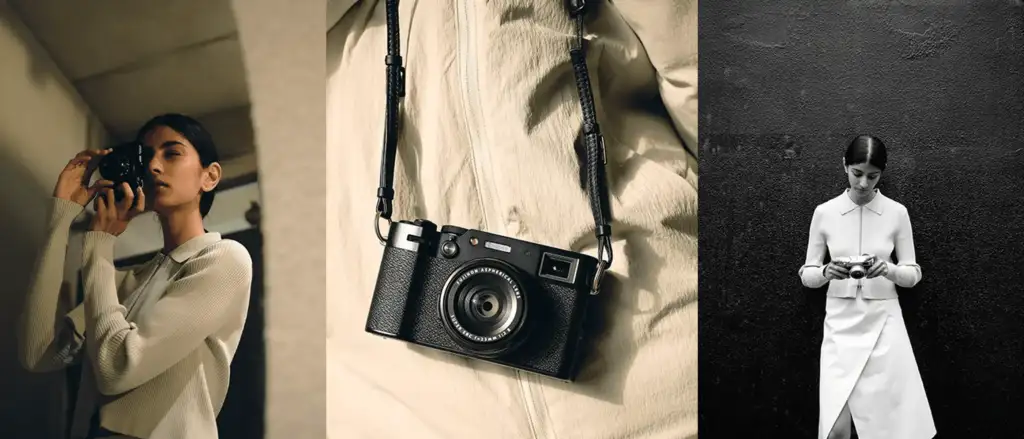Share This Article
Learn more
OVERVIEW
Fujifilm X100VI vs X100V
Last update on 2025-05-18 / Affiliate links / Images from Amazon.
Fujifilm X100VI
The Fujifilm X100VI offers outstanding image quality in a small package by fusing traditional style with contemporary capabilities. Its sophisticated sensor, quick focusing, and well-known Fujifilm color science make it an excellent option for street and vacation photography.
For
Against
Fujifilm X100V
The Fujifilm X100V is a stylish, small camera with contemporary functionality combined with an analogue aesthetic that makes it ideal for street and travel photography. It produces amazing image quality in a portable size factor because to its sophisticated sensor and sharp fixed lens.
For
Against
It’s intriguing to compare the Fujifilm X100VI vs X100V since, at first glance, it might not seem like the most recent X100 camera has undergone any changes.
The cameras have the same fixed 23mm focal length lens, same knobs, and identical ports. The bodies of the cameras are nearly identical. The Fujifilm X100VI’s internal components are where you’ll start to notice differences between the two models.
What specific changes have been made to Fujifilm’s high-end compact and TikTik icon? Examining the differences below, let’s determine which is the best choice for you.
SPECS
Fujifilm X100VI vs X100V
| Specification | Fujifilm X100VI | Fujifilm X100V |
|---|---|---|
| Sensor | Likely 26.1MP X-Trans CMOS VI | 26.1MP X-Trans CMOS IV |
| Lens | 23mm f/2 Fixed Lens | 23mm f/2 Fixed Lens |
| Autofocus | Likely Improved | 425-point Hybrid AF |
| Video | 4K 60fps (Expected) | 4K 30fps |
| ISO Range | Expected 160-12,800 | 160-12,800 |
| Weather Resistance | Likely Improved | Optional with filter |
| Display | Tilt LCD (Potentially Fully Articulating) | 3.0″ Tilt LCD (Non-Articulating) |
| Battery Life | Expected Slight Improvement | Approx. 420 shots per charge |
| Dimensions | Slightly Bulkier (Estimated) | 128 x 75 x 53 mm |
| Weight | Slightly Heavier (Estimated) | 478g (with battery and card) |
Last update on 2025-05-18 / Affiliate links / Images from Amazon.
SENSOR
Fujifilm X100VI vs X100V

X100VI: 40.2MP X-Trans CMOS 5 HR sensor
X100V: 26.1MP X-Trans CMOS 4
The primary distinction between the two cameras, despite their APS-C sized sensors, is resolution. The manufacturer’s most recent and greatest cameras, the Fujifilm X-H2 and X-T5, have used the 40.2MP sensor found in the newer X100VI. This sensor features 66% more pixels than the 24.1MP sensor in the X100V, setting a new standard for APS-C resolution.
Why is this relevant? Having a higher resolution makes it possible to crop your photographs even more, which is crucial because the X100 series’ lenses lack optical zoom. You may obtain 10MP photos by digitally cropping to 70mm with the more recent X100VI sensor.
You may also print larger thanks to the higher quality; 40.2MP easily produces large-sized photographs for exhibition or home display.
PROCESSOR
Fujifilm X100VI vs X100V

X100VI: X-Processor 5
X100V: X-Processor 4
Faster buffer rates, better noise reduction, better video processing, better autofocus tracking, and generally a quicker camera in usage are just a few benefits of having a powerful processor. For the most part, the new camera outperforms the old one in this regard.
Editor’s Choice
While the Fujifilm X100V only features human face and eye detection albeit with outdated algorithms, the X100VI’s focusing system also includes animal, bird, insect, vehicle, and drone recognition and tracking. The Fujifilm X-H2S and GFX 100 II are two of the professional cameras in the company’s lineup that have already been equipped with the newest detecting algorithms.
The buffer, or the number of consecutive shots, has been grown; the Fujifilm X100VI can now capture 117 JPEGs (as opposed to the X100V’s 79) and 52 RAW images out of a total of 17. But there is no difference in the buffer rate with the mechanical shutter between the two models.
When it comes to shooting speed, the older X100V has a minor advantage over the X100VI, since it can shoot at 30 frames per second as opposed to 20 frames per second with an electronic shutter only. This is probably because the more recent camera uses more megapixels and strains the processor more. Actually, this is less likely to matter because the X100 series is neither a sports or wildlife camera.
Last update on 2025-05-18 / Affiliate links / Images from Amazon.
VIDEO
Fujifilm X100VI vs X100V

X100VI: 6K 30p (1.23x crop), oversampled 4K 30p (1.23x crop), 4K 60p, FullHD 240p
X100V: 4K 30p, FullHD 120p
Although the X100 series isn’t the best option for serious filmmaking, if you’re eager to record both still and moving images, this is where the cameras truly differ, with the X100VI emerging as the clear winner.
The 6.2K video at up to 30p on the X100VI surpasses the 4K 30p footage on the X100V, making a significant improvement. There is also a setting on the X100VI that allows you to oversample 6.2K video and store it as higher quality 4K film. The X100VI’s two modes are limited to a 1.23x crop, which results in a 28mm lens rather than a 23mm lens. This is the single drawback to the camera. For greater editing versatility, the X100VI can also record 4:2:2 10-bit footage.
In-body image stabilization, which the X100V lacks, is the last string in the video bow of the X100VI. We’ll talk more about this feature below.
IMAGE STABILIZATION
Fujifilm X100VI vs X100V

X100VI: Up to 6.0 stops
X100V: None
Fujifilm has succeeded in incorporating in-body image stabilization (IBIS) into the X100VI while only slightly enlarging the camera (by a few millimeters). This is a significant upgrade over the previous model, especially because the X100V lacks any stabilization at all.
With the X100VI boasting you can set the shutter speed down to 6.0 stops lower than you could without it, IBIS enables steadier shots in low light situations where shutter speeds need to be slower or balancing the camera while using long lenses. Additionally, IBIS greatly enhances video quality by mitigating handheld shake that may occur while attempting to hold a stable camera or pan slowly.
However, image stabilization might not be that important to your work if you simply use small lenses and decent lighting for your images instead of recording video.
VERDICT
Fujifilm X100VI vs X100V
Here’s a brief summary of the top new features between the Fujifilm X100V and X100VI; should you upgrade? It’s a difficult one since, although the Fujifilm X100VI has all-around better specs than the X100V, the technological advancement isn’t significant enough for me to advise buying the more recent model right away. The X100V’s sensor and lens can continue to produce amazing photographs for many years to come, so it doesn’t feel antiquated or old.
The X100VI is the simplest option if you’re looking for your first camera from the X100 series. The X100V is no longer available for purchase, but you can still get it brand-new from a retailer, and it will provide you greater future-proofing because it will hold its value against newer versions for longer and probably receive firmware updates for the foreseeable future.
- 40.2MP X-Trans CMOS 5 HR Sensor
- Up to 6.0 stops In-Body Image Stabilization
- 4 stop Internal ND
Last update on 2025-05-18 / Affiliate links / Images from Amazon.
Even if the camera has kept its worth, you might be able to find the older Fujifilm X100V model used for less money if money is a concern. Purchasing a less expensive model can be a better method to test the waters before committing to the more expensive X100VI if you are also unsure about how well you will get along with a fixed-lens compact camera.
- Great Photography Every Day, Everywhere: X100V features a newly designed, incorporated 23mmF2...
- Designed for Quality and Speed: From fleeting holiday moments and family celebrations to...
- Two ways to See an Image: To truly convey the magic of a scene, you need to be immersed in the...
Last update on 2025-05-18 / Affiliate links / Images from Amazon.
Why Trust Factic
Berry Alex has been evaluating, testing, and reviewing tech, Household and travel items for several decades. He compiled all of the tester’s input, conducted extra research to assess each phone mount’s essential features and overall functioning, and reviewed professional profiles and verified customer reviews for each product.



